
|
Lorna Mills and Sally McKay
Digital Media Tree this blog's archive OVVLvverk Lorna Mills: Artworks / Persona Volare / contact Sally McKay: GIFS / cv and contact |
View current page
...more recent posts

| Top ten science fiction/speculative fiction novels Sally McKay was reading and/or pondering this year, with various tangentially related images for illustration. 1. Year of the Flood, by Margaret Atwood  I picked these scenes from 28 Days Later to illustrate Margaret Atwood's Year of the Flood because there are some real similarities, both in plot and atmosphere. In Atwood's book it's the near future and due to a technoscience catastrophe in genetic manipulation humans are pretty much done for while everything else organic, including weird new species, has started taking over. There are scary, macho, militaristic dudes with knives and guns and tough survivalist women who figure out how to deal with them. The main characters belong to a religious cult based on environmentalism and science. In their incantations they rhyme off their Saints, including Saint James Lovelock, Saint Stephen Jay Gould of the Jurassic Shales, Saint E.O. Wilson of Hymenoptera, and Saint Dian Fossey, Martyr. Oh, and Saint Jesus of Nazareth, Fish Conservationist. Atwood is really riffing in this book, and in parts the fast-paced complexity of cultural-referencing starts to feel almost like William Gibson or maybe more like Douglas Coupland. Anyhow, it rocks, and it's way more fun that some of her other dystopias, like Handmaid's Tale. Year of the Flood is an excellent sequel to Oryx and Crake (which I also loved) but it totally stands up on its own. 2. Dhalgren, by Sam Delaney 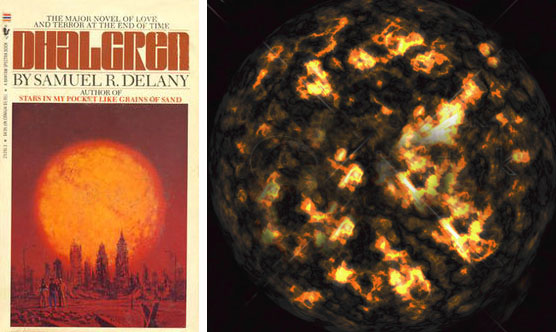 Urban sex and violence and the end of the world. Delaney writes great characters and sets them in a situation that is never really explained. Everything is fucked up. The sun is fucked up and the world seems to be ending. People are banding together in tribes and cliques in the streets of a big city (New York). Squatting, fighting, foraging, partying. The main character is queer and charismatic, one of those unwilling leaders who is forced to learn how to wield his power. It's a door stop, and a page-turner. I thought about using Escape from New York as an illustration because there's, you know, hedonism, punks and street gangs and fires-in-a-barrel. But there's an existential streak in Dhalgren that keeps it more interesting than just a porny paperback, and the book's cover, with all it's sci-fi cheese, is perfect. I also picked a stock photo of a dying sun. 3. Enchantress from the Stars, by Sylvia Louise Engdahl  I really ought to read this one again. It's been about 35 years. Here's what I remember — People from a technologically advanced sciencey planet show up on a peasant-type planet that has been taken over by a bunch of resource-extracting developer-types from a business-oriented planet. The advanced technology people are there to intervene and help the peasant people but they have a Star Trek-style prime directive thingy so they can't let the peasants in on any of their science secrets. The developer people have bulldozers plowing down villages and forests and the peasant people think the machines are monsters. The techno people pretend they are sorcerers and enchantresses so they can use their science weapons on the bad guys. Oh, and they have telepathic powers, which they have to hide. But it turns out that some (well, one) of the peasant people have telepathic powers too. Of course there's a transgressive peasant/techno BFF/love affair (written for 12 year olds). There's a frigging great scene where the main telepathic technology "enchantress" gives the main telepathic peasant character a wadded up bit of bread and tells him/her (can't remember the gender) that it's a magic pill that will block out pain because the peasant person is about to get captured by the baddies for some kind of torture. The peasant person is really smart and figures out that the so-called enchantress is messing with his/her head... stupid fake bread pill, not magic at all, etc. But the enchantress person breaks the prime directive, and, through the awesome power of telepathy, manages to communicate with the prisoner in his/her cell, and lets him/her know that yes, the bread pill is a fake but he/she has the power within himself/herself to detach from the pain and withstand the upcoming torture. Crazy! And It works! In the end, this being a kids' book, the smarty pants magic/techno people and the peasant people manage to drive the developer people away and then the techno people also leave so the peasant people can get back to their normal lives. But it's very sad because the main peasant character has had a taste of advanced science/telepathy/magic/technology but now has to stay behind in the muck to be a leader for future generations (at least, that's how I remember it, it's been a loooong time). 4. Neuromancer, by William Gibson 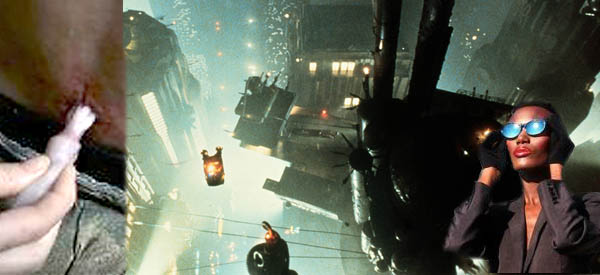 Who do you like better, William Gibson or Neal Stephenson? Stephenson can do character development and create a compelling narrative, but Gibson broke the seal on cyberpunk with his ruthless, hard-edged postmodern use of language. Gibson was a master of the plausible near-future and Neuromancer introduced readers to a world that was awful, familiar, prescient and also kind of fun. I chose Existenz as an illustration because the visceral, spine-crunching depictions of jacking-in evoke the kind of painful reality-wrenching that Gibson's characters undergo when they shift in and out of the matrix (way better than the smoothed off edges of The Matrix movies). I chose Blade Runner because, well it's just the best cyberpunk movie ever. Von Bark tells a tale of Gibson going to see Blade Runner right before Neuromancer came out and falling into a pit of despair because he felt like he'd been scooped. I chose Grace Jones because that's who I'd cast to play Molly. 5. Ridley Walker by Russell Hoban 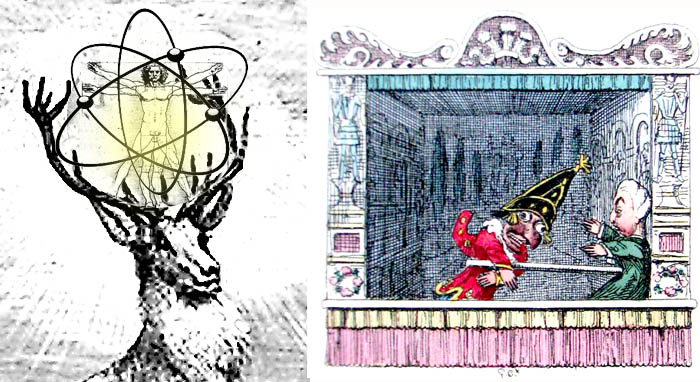 Originally I was going to leave this one off because others seemed to be more in the forefront of my mind, but while working on this list I realised that some small part of my brain has been permanently assigned the task of thinking about Ridley Walker all day, every day. The book takes place in an invented language and you just have to keep reading until you get into the groove and start to understand it. It's a post-nuclear-disaster, medieval-style, pagan-ish society on the brink of re-discovering some get-us-out-of-the-dark-ages technology. Their creation myth is great, enacted in the form of a punch and judy style traveling puppet show. In the hart of the wood there's a little shining man, named Addom, who get's split in two. The hart of the wood is both a big stag, with a little dude hanging out between his antlers, and the heart of a tree, which provides fire. Some hero named Eusa did the whole Addom-splitting thing. Here's an eerie snippet from the post-apocalyptic lore. Owt uv thay 2 peaces uv the Little Shynin Man the Addom thayr cum shyningnes in spredin circels. Wivverin & wayverin & humin with a hy soun. Lytin up the dark wud. Eusa seen the Little 1 goin roun & round insyd the Big 1 & the Big 1 humin roun inside the Littl 1. He seen thay Master Chaynjis uv the 1 Big 1. Qwik then he riten down thay Nos. uv them.I collaged my own illustration of the little shining man riding the stag (Hoban himself was in part inspired by the story of St. Eustace who allegedly came across a stag with a little shining crucifix. I don't know how Eustace relates to Hubertus, but this is where I got my stag.). Of course there's also the whole Jabberwocky/crawling in the muck/medieval peasant thing going on too...with Punch n' Judy to make life bearable. 6. Never Let Me Go, by Kasuo Ishiguro   I loved this book so much that I can't bring myself to see the movie. Ishiguro is probably best known for Remains of the Day. There's a similarity, in that the characters are contending with unthinkable horrors by shifting between states of denial and resignation. Life goes on. Augh! It's horrible. I chose Charlotte's Web as an illustration because as I child I was utterly creeped out by the idea that humans could slaughter a talking pig and I was traumatized by the pathos of a spider and pig bonding out of necessity under such dire, tragic conditions. Never Let Me Go inspires the same feelings in me (except now I am a grown-up and the characters are human). And Animal Farm...well...it's just more of the moreness, only it's about how individual critters internalize state oppression so that the situation becomes self-perpetuating. OOf. It's all too nasty, but Ishiguro is such a good writer that the misery is somehow mitigated and everything that happens feels like it's bathed in a clear and watery light. That's why I chose the sanitorium. 7. The Left Hand of Darkness, by Ursula K. Le Guin 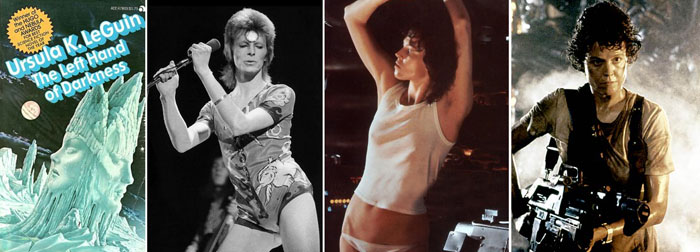 I read this book several times when I was a kid because it just seemed so sensible compared to everything else out there. People can be androgynous — D-uh! There's some setting and plot and stuff like that but I forget it. The cover is a classic and the other images...well, let's just say that science fiction does gender-bending really, really well sometimes. 8. Fiasco, by Stanislav Lem 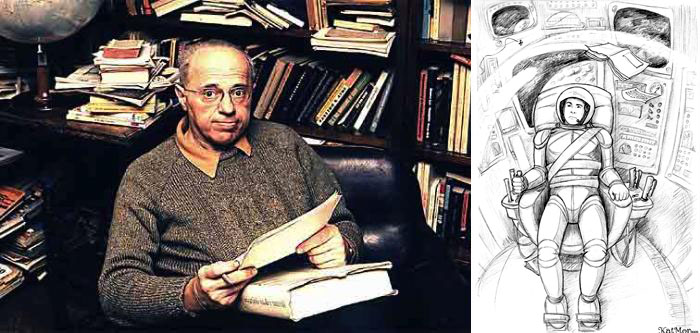 I restricted myself to one book by Lem because otherwise everything on this list would be by him. I don't want to write spoilers for Fiasco. I will say that the story lives up to the title. Lem is really really good at metalevels of thought and meaning. His plots are often quite unhinged, and, pre-cyberpunk, his characters slip in and out of various sorts of reality. But, you know, it's human astronauts in space dealing with time, technology, and the possibility of life of other planets. Sounds like classic sci-fi and it is - Lem's powers of description are great and the stories are gripping. His combination of philosophy & boys home adventure makes for rip-roaring tales with really awesome mind-bending twists. In Fiasco the world remains pretty consistent, but the story is a tangle of tangents, all of them page-turners, and everything classically structured to return the reader to the urgent, over-riding narrative. I chose this picture of Lem himself because you can see in his face how much fun he's having and that mischievous teasing is there in the prose as well (and comes through great in translation). Plus a really great fan drawing of Lem's recurring character, Pirx the Pilot. 9. Anathem, by Neal Stephenson  As implied above, back in the 90s Neal Stephenson gave William Gibson a bit of a run for his money in the cyberpunk genre. Stephenson's narratives were a little tighter and his characters a little less adolescent, but Gibson always had the edge with his fantastic lingo. Eventually Stephenson stopped writing straight-up sci-fi and moved into historical fiction about science and technology. Anathem is a return to the classic sci-fi arena, and this time it's all about language. It's as if Stephenson decided to take one more crack at Gibson, this time on Gibson's terms.* Anathem is full of made-up words, complete with etymological footnotes and dictionary definitions. At first I thought it was too clunky and forced. But after a while the cultural history of the fictional language just seemed to seep in and take on a deep, rich texture. I chose a big old monastery as an illustration because the book takes place in a setting much like this and — small spoiler — outer space is outer space. It's kind of like A Canticle for Leibowitz, only the story just charges along. Another door stop page-turner. Perfect for staying in bed or travelling. *I'm not totally fabricating this rivalry. Read this, it's hilarious. 10. Mocking Bird, by Walter Tevis 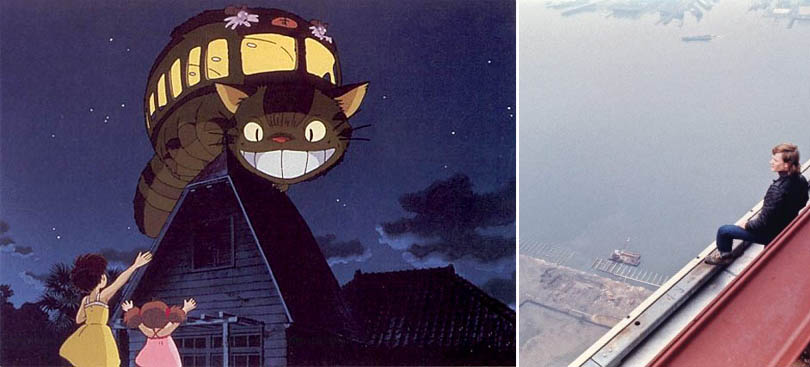 Are people getting stupider? I read this book right after watching Idiocracy. Mockingbird is better — mournful, heart-wrenching, nuanced. Yup, it's the future and everyone has become really, really stupid...and it's up to a couple of autodidacts to save the day. Autodidacts are the tribe I want to belong to, because while our puttering, quixotic information-seeking processes can seem rudderless at times, it's people who gain their knowledge through enthusiasm that really know how to spread it around. Mockingbird was published in 1980 but it keys right into 21st century anxieties.* There's a sad sad intelligent cyborg who just wants to die (but can't), an empathetic thought bus, and a couple of canny humans who teach themselves how to read and get a grasp on history. And a cat. I chose Miyazaki's cat bus as an illustration because of the obvious thought bus/cat bus connection, but also because the tensions of darkness and light in My Neighbour Totoro are laced with a similarly melancholic sense of hope. I picked the image from Man on a Wire beause it relates directly to the plot, but also for it's greyed-out, atmospheric, existential clarity which is the kind of feeling that permeates the book. *I don't believe for one second that people are getting stupider. But there's a polarized battle front emerging with we-don't-read-books-and-we're-proud-of-it types on one side and snobby-elitist-academic-ivory-tower types on the other. yike. As an auto-didact, I feel like I'm being forced to take sides and I don't like it. |
R.M. Vaughan's Top Five Disappointments of 2010 (it was such a disappointing year, I can't even come up with 10)
The Death of Gary Coleman

I always supposed that Gary Coleman would have a comeback - get a talk show, or a radio show, or a recurring part in an HBO series. Something. He was due: producers made millions off of him, but his parents stole his money, and then he tried to be a rapper and then he tried to be a preacher (and if you can't make money being a preacher in America, you are truly cursed). He married unwisely, and, of course, did not grow to an adult height.
The Elizabeths (Taylor and Windsor) continue to disappoint. They are just full of life.
Prince Harry

Speaking of the Windsors, Prince Harry is obviously on some very tight leash (maybe the Queen looked fish-eyed at him and made vague references to Parisian traffic?). He has not fallen in front of a cell phone camera red-nosed drunk, or in a Nazi costume, nor been photographed playing nipple bingo with his army buddies, all year long. Harry, Harry, Harry - you have a life of complete irrelevance awaiting you, why are you not acting like the wastrel you were bred to be? At least get caught with a tranny tart in 2011. You have a duty to your subjects.
Art World Crybabies

As at least 12 of you have noticed, I've taken to writing about art for The Globe and Mail. It's a nice job, for a people person such as myself - but, yikes, the hate mail! I can write the word "genius" next to an artist's name 99 times, and then finish off with the word "probably", and I'll get weeks and weeks of cunty emails. As Sky Gilbert once said to me, "what would these people do if they were in theatre, where an entire career can be destroyed by one 300 word review, written past the author's bedtime, in haste for the morning edition?" Indeed. In my own sad little enterprises, I've gotten the five stars and I've gotten the zero stars. On the latter occasions, I had a nice little cry and then carried on. But then, I'm an Atlantic Canadian. We fetishize disappointment.
The Departure of Nadja Sayej

Oh, now, stop it, stop yer fussin'. You know you watch her Artstars* videos, you know they make you laugh. And yet, you ran her out of town (see paragraph above). Say what you like about Nadja's journalistic practice, but she started a long-overdue conversation about the too ponderous tone of art reckoning in Toronto. Now she's doing it in Berlin - because that's what we do in Toronto, we drive all the clever people off the continent. Funny thing is, if she ever comes back, all you bitches will be clawing for her attentions, because she'll have been Berlinified, and you're nothing but a pack of whiny colonial neurotics. There, I fucking said it.
Democracy
The batteries are low. Not dead, but low, vole-belly low. For instance, in the recent civic election, I realized, as I sat behind the cardboard and made my marks, that I was voting for two gay men, neither of whom I actually wanted to represent me, in order to block the possible (and, it turned out, inevitable) win of two heterosexuals I really did not want to represent me. A pity date is not social progress.
Ross Angus Macaulay and Marlaina Buch' s Top 20/10 List (in no particular order)
FASTWURMS - Hood Woad at the Ministry of Casual Living, Victoria
The presence of a billboard sized, hot pink pentagram flag only upset one retirement party.

Die Antwoord - Launch of $O$ album, Commodore Ballroom, Vancouver
There's nothing hard to understand about Die Antwoord, people. They're from South Africa. Things work a bit differently there.

Ryan Trecartin - Any Ever at the Power Plant, Toronto
Your average day on Robson Street, now in contemporary art format for greater digestibility.

Alexis Gideon - Video Musics II: Sun Wu-Kong at Disjecta, Portland
Journey to the West related through the mediums acid rock and animation to a packed house in a post-war (does post-war even mean anything in America?) Portland burrough for five bucks.

Alison Pebworth - Beautiful Possibility, across Canada and the US
An entirely self-produced touring project as finely crafted and considered as Alison's handmade pioneeress outfits.

Adventure Time - The Cartoon Network, Everywhere
Stoner Bear/Man producer rolls out a charming, hazardous world charted by adorable protagonists surprisingly free of moral rectitude.

VanHalentine's Day Dance - Ministry of Casual Living, Victoria
IF YOU'RE NOT DANCING, YOU'RE GARBAGE.
Joon-ho Bong, Mother - at the Bloor Cinema? Toronto
DIY acupuncture and revenge.

Ross Macaulay and Luey McQuaid duet "Fire in the Disco" - Thanksgiving Day, The Astoria, Vancouver
The pregnant bartender says, "I think my baby likes this song."
Meatpaper Magazine - Issue 12, picked up in Portland
Did you know - dressing up your placenta used to be common practice?!

illustration by Emily L. Eibel
| Gabrielle Moser's Top Ten 1. Oliver Husain at the Art Gallery of York University 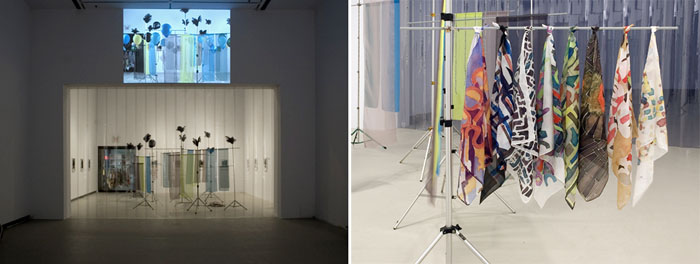 Photos by Cheryl O'Brien I think this is the first show I saw in 2010, and it set the bar pretty high. I love Husain's playful installations which combine unexpected, seemingly fragile materials with beautiful video pieces and audience interaction (The fan! The balloons! The scarves!). The AGYU solo show was impossible to explain to other people, and yet I kept talking about it all year. I still haven't caught his new solo show currently up at Susan Hobbs, but it is first on my post-comps viewing list. 2. "To Be Real," Althea Thauberger, Lars Laumann, Helen Reed, Prefix ICA, curated by Rose Bouthillier 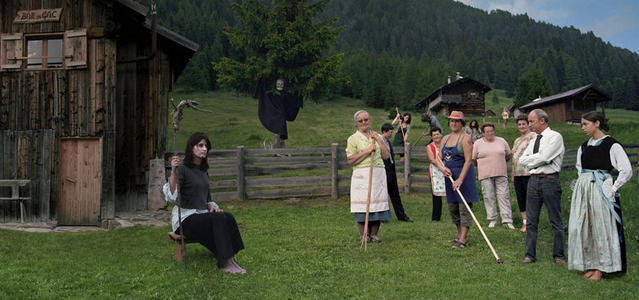 Althea Thauberger This group show on art, ethnography and fandom, curated by recent OCAD Criticism and Curatorial Practice grad Rose Bouthillier, hit just the right mix of earnest and ironic for me. It was nice to see Althea Thauberger's work in Toronto, which seems to happen rarely, and to see Lars Laumann's very strange Berlinmuren put into conversation with Helen Reed's fantastic co-production with a bunch of Twin Peaks fan fiction writers (it helped that I was also re-watching Twin Peaks from the beginning at the same time). 3. Ryan Trecartin at the Power Plant, curated by Helena Reckitt and Jon Davies 
I usually have video art attention deficiency problems and find it difficult to sit through anything longer than 7 minutes, but I had to be pulled away from the beds, airline seats, picnic tables and bleachers that populated Trecartin's show at The Power Plant. The solo show was a big scoop for the gallery and, whether you love or hate Trecartin's frenetic, over-the-top productions, you couldn't deny that this seemed like an "important," truly international-caliber show. And, as Terence Dick pointed out in his list, after seeing so much work these past two years that was historiographic and obsessed with the past, it was refreshing to see an artist whose aesthetic seemed to herald something about the present/future. 4. "No Soul for Sale: A festival of independents" at the Tate Modern, curated by Maurizio Cattelan and curators Cecilia Alemani and Massimiliano Gioni  Black Dogs I caught this exhibition over two days at the Tate Modern while I was living in London. It marked the 10th anniversary of Tate Modern and invited more than 70 artist-run centres and non-profit/independent arts organizations to co-habitate in the Turbine Hall. The event was not without its political and organizational problems, such as a lack of artist fees or travel funding (some of them are outlined on Black Dogs' website, which used the event to discuss the implications of an "independent" event in a large institution like the Tate: http://www.black-dogs.org/index.php?/recent-current/how-not-to-sell-your-soul-at-tate-modern/), but it was also unlike anything I have ever seen before, and wandering amongst so many exhibits and events from all over the world did drive home the point that incredible things are happening in artist-run culture, in spite of (or because of) increased neoliberal pressures. 5. Wangechi Mutu at the Art Gallery of Ontario, curated by David Moos (I think?) 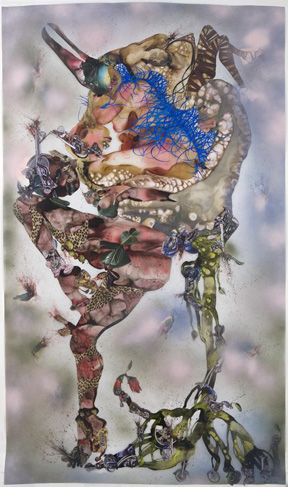 Maybe the biggest surprise of 2010 for me was Wangechi Mutu's solo show at the AGO, "This You Call Civilization?". After reading many critics' responses to her work, which can be a bit over-the-top (the pock-marked walls, for instance, were a bit much for me), I didn't expect to like the show, but Mutu's large-scale collage works, especially the ones that incorporate medical diagrams of women's reproductive "ailments", were both comical and icky. 6. Tacita Dean's "Craneway Event" at Gallery TPW, curated by Kim Simon  A co-presentation with the Images festival, this 16mm film that charts several days' rehearsal of Merce Cunningham's "Craneway Event" dance performance was more watchable and engaging than every commercial movie I saw this year. I brought several people to see it during its all-too-short run and kudos should be given to Kim Simon for bringing Dean's work to Toronto and presenting it with just the right amount of reserve. 7. Katie Bethune-Leamen at MKG127  I loved Bethune-Leamen's wacky mix of Victorian arctic explorers, experimental orchestral synth-pop, dazzle camouflage and Cold War spies. Her videos, sculptures and paintings were gorgeous to contemplate on their own, but also offered up more nuanced, layered meanings the longer you stayed with them and the more background research you unearthed about her references. 8. Ken Lum at Vancouver Art Gallery Offsite  Lum's from shangri-la to shangri-la seemed the perfect, subtle commentary on the effects of the 2010 Winter Olympic Games on Vancouver, recreating several shacks from the Maplewood Mudflats–the site of 1960s artistic radicalism on the city's North Shore where Malcolm Lowry and Tom Burrows both created work–at the Vancouver Art Gallery's "Offsite" location at the base of the city's largest building, a luxury hotel/condo complex called The Shangri-La. Whether you drove by it on your way to the North Shore, or saw it up-close, it was an understated reminder of the city's trajectory through urban development. 9. "Un-homely" at Oakville Galleries, curated by Matthew Hyland 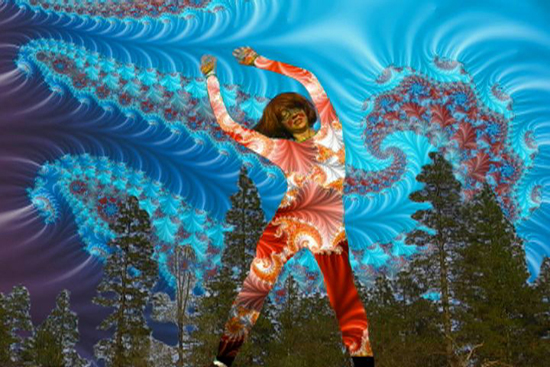 Shana Moulton This two-site group show on the feminist uncanny was a pleasant reminder of what Oakville can do when it tackles a great combination of works in an original way (the Centennial location has never looked so different). Standouts were Paulette Phillips' new video work, seeing Martha Rosler's "Semiotics of the Kitchen" in larger-than-life scale and getting to watch Shana Moulton's "Whispering Pines" series in full. I'm already looking forward to the other exhibitions in the gallery's three-year series of feminist projects. 10. My favourite art discoveries of this year: Karen Asher's photography, Margaux Williamson, Carl Wilson and Chris Randle's blog Back to the World, Ryan Trecartin's list of inspirations/directions for his W magazine spread, "Studies in Motion" by the Electric Theatre Company, Bravo's "Work of Art" reality TV disaster, and the realization that NFL football makes pretty great animated gifs. |
Sunday - Miss Piggy
Woman w/ Raquel Welch
Never on a Sunday
Fuck the Pain Away